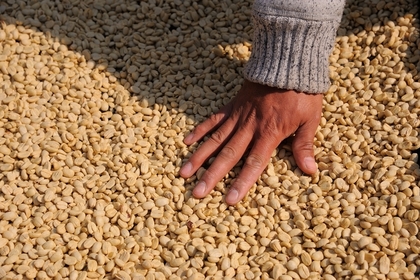How to deal with the processing of Tanzania single bean? how to divide the grade of Tanzania single bean?

For professional baristas, please follow the coffee workshop (Wechat official account cafe_style)
The coffee beans produced here are all exported from Kilimanjaro, but apart from Mount Kilimanjaro, there are several major coffee-producing areas throughout Tanzania, there are more small farms in other areas, and most small farms also have a planting area of several hundred mu. Some have their own washing equipment and drying farms, but graded treatment still has to go through large-scale treatment plants. Tanzania has considerable historical experience in growing coffee, and even small farms can handle good quality coffee beans.
Drinking Tanzanian coffee, especially the small round bean peaberry, is always impressive. Coffee is like the simple, frank and enthusiastic national character of Tanzania. Its refreshing acidity and medium mellowness complement sweet citrus and floral aromas. This coffee tastes great whether it's a hot drink or iced coffee. With oranges or berries, it can show its bright flavor. You can experience that different ethnic groups produce different coffee flavors, while the same land is pregnant with coffee trees and people at the same time.
Coffee beans in Tanzania are of extraordinary quality. They are produced in the Mohi district near Mount Kilimanjaro. The mountains with a height of 3,000 to 6,000 feet are the most suitable areas for growing coffee. The fertile volcanic ash gives the coffee here a strong texture and soft acidity. It exudes delicate aromas and contains aromas of wine and fruit, making people taste endless aftertaste. After drinking Kilimanjaro coffee, I always feel a soft and mellow earthy smell around my mouth. Coffee gourmets often use words such as "wild" or "wild" to describe it. It can be said that pure Kilimanjaro coffee is "the most African coffee". Kilimanjaro AA is the highest grade of beans, its grains are full, pure flavor, rich and refreshing, all aspects of quality are good. It is usually milder acidic than Kenyan coffee and evenly stimulates the taste buds in the middle and sides of the back of the tongue, feeling a bit like tomato or soda. After moderate or more moderate baking, it has a strong aroma, then grind it into a fine powder, soak it in a pot of boiling water, and invite friends to sit around and taste it. The famous coffee brands in Tanzania, such as Africafe, Tanica Cafe, Kilimanjaro and so on, are of much better quality than the Nestle coffee we often drink. Tanzanian coffee has long been loved by Europeans and has joined the ranks of famous products. Europeans give Tanzanian coffee the nickname "coffee gentleman", and Chinese coffee connoisseurs call it the "coffee swordsman" with the mocha of the "King of Coffee" and the "Lady of Coffee".
Coffee is one of the main cash crops in Tanzania, ranking fourth after cotton, tobacco and cashew nuts, mainly sold to Italy, Japan and the United States. Coffee exports play an important role in the national economy of Tanzania. Tanzania's main coffee-producing area, located at the foot of Mount Kilimanjaro, is rich in volcanic soil. Some coffee trees are more than 100 years old. Coffee was first introduced and planted by Christians from Kenya. Coffee trees must be carefully cared for, weeded, fertilized, and old branches must be cut off so that new branches can grow to maintain the quality of coffee beans. The processing plant is located in a nearby town at the foot of the mountain, making it easy to handle coffee beans nearby. Many of the farm owners' families have lived here for generations of immigrants, including Indians, Scandinavians, British, and, of course, locals, but most of them are small farms. however, the managers of farms and processing farms are mostly local people. Labor in Tanzania is cheap, so much of the work of pruning and maintaining coffee plantations in Tanzania depends on manual processing rather than machines. During the coffee growing season, the job of coffee workers is to manually check to remove the leaves of some sick or growing insects. Coffee processing in Tanzania is highly dependent on labor, but it also brings jobs to locals and increases household income. Workers earn their wages by harvesting the amount of coffee fruit, and small farm women use their hand-made sacks to bring coffee fruit to the farm to calculate the money.
Due to political instability and rampant diseases and insect pests, the coffee industry in Tanzania has been damaged, resulting in a decline in the overall level of coffee and instability in quality, which in turn lead to lower prices, which is usually the result of a further decline in the coffee industry. What's more, it is estimated that more than 12% of the Arabica coffee grown in northern Tanzania from 1969 to 1985 was smuggled into Kenya. Recently, however, the country's coffee industry has shown signs of improving. Although the process of improvement is slow, it is still encouraging because, after all, the quality of coffee in Tanzania is excellent.
In the past, the coffee industry in Tanzania has been dominated by manor cultivation, but now more than 85% are grown by small farmers. Many small farmers form cooperative organizations, the most important of which is the Kilimanjaro Cooperative Alliance (Kilimanjaro).
Cooperative Union (KNCU for short). Tanzanian coffee is auctioned by the Tanzanian Coffee Management Committee (Tanzanian Coffee Marketing)
Board (TCMB for short) is sold to private exporters. In the 1980s, most coffee sales in Tanzania changed from auctions to being sold directly to the Coffee Management Committee of Tanzania, and the coffee industry is being reformed to allow individuals or groups to buy coffee in the future. at that time, coffee will have to be graded in different ways in order to attract buyers from Germany, Finland, Belgium and Japan.
Tanzania Tansania
Population: 44929000
Tansania produces a reasonable number of Robbot beans, concentrated in the northwest and around Lake Victoria. The rest of the area uses the nature of high altitude to grow coffee beans.
KILIMANJARO
This area is the oldest growing Arabica bean in Tanzania and, of course, there is plenty of time to build international visibility and reputation. With a long tradition of coffee production, good infrastructure and equipment have been established, but many existing coffee trees are old and their yields are low, and coffee beans are increasingly facing competition in production.
Altitude: 1050-2500m
Harvest: July-December
Varieties: Kent, Bourbon, Typica, Typica/Nyara
RUVUMA
This area, named after the Ruvuma River River, is located at the southernmost tip of Tansania. Coffee growing areas surround the Mbingo area, which is generally believed to have the potential to produce high-quality coffee beans, even though there was a lack of economic access in the past.
Altitude: 1200-1800m
Harvest: June-12
Variety: Kent, Bourbon, Bourbon derivatives such as N5 and N39
Gourmet coffee has soft acidity and attractive aroma, which is absolutely worth enjoying.
Coffee exports from Tanzania (Tanzania) play an important role in the whole national economy. Bean-shaped berry coffee is very productive and is said to be more fragrant than ordinary coffee. Generally speaking, the coffee beans in Tanzania have an extraordinary quality. For example, the best AA coffee (Chagga) from Tanzania is produced in the Moshi area near Mount Kilimanjaro in Tanzania.
AA) is famous for its fullness and fragrance.
Important Notice :
前街咖啡 FrontStreet Coffee has moved to new addredd:
FrontStreet Coffee Address: 315,Donghua East Road,GuangZhou
Tel:020 38364473
- Prev

How is the planting of single bean in Tanzania? introduction to the award-winning situation of single bean in Tanzania
Communication of professional baristas Please pay attention to Coffee Workshop (Wechat official account cafe_style) Tanzania coffee beans are of extraordinary quality and are produced in the Mohi district near Mount Kilimanjaro. The mountain area with a height of 3, 000 to 6, 000 feet is the best place for growing coffee, where fertile volcanic ash gives the coffee a strong texture and soft acidity. What it emits.
- Next

Does Rwanda's single bean taste good? the planting and processing of Rwanda's single bean
The exchange of professional baristas please follow the coffee workshop (Wechat official account cafe_style) Bourbon coffee grown in Rwanda is one of the original varieties of Arabica coffee. In the annual professional evaluation of top coffee held by SCAA of the American Fine Coffee Association in 2008, Rwanda Aromec of Rwanda was the best washed bourbon, winning the championship and beating the contemporaries.
Related
- Does Rose Summer choose Blue, Green or Red? Detailed explanation of Rose Summer Coffee plots and Classification in Panamanian Jade Manor
- What is the difference between the origin, producing area, processing plant, cooperative and manor of coffee beans?
- How fine does the espresso powder fit? how to grind the espresso?
- Sca coffee roasting degree color card coffee roasting degree 8 roasting color values what do you mean?
- The practice of lattes: how to make lattes at home
- Introduction to Indonesian Fine Coffee beans-- Java Coffee producing area of Indonesian Arabica Coffee
- How much will the flavor of light and medium roasted rose summer be expressed? What baking level is rose summer suitable for?
- Introduction to the characteristics of washing, sun-drying or wet-planing coffee commonly used in Mantenin, Indonesia
- Price characteristics of Arabica Coffee Bean Starbucks introduction to Manning Coffee Bean Taste producing area Variety Manor
- What is the authentic Yega flavor? What are the flavor characteristics of the really excellent Yejasuffi coffee beans?

